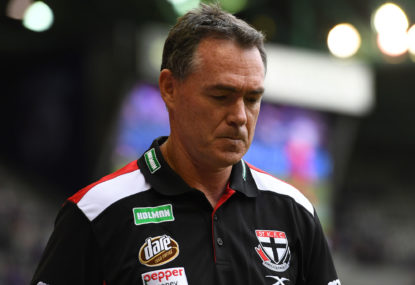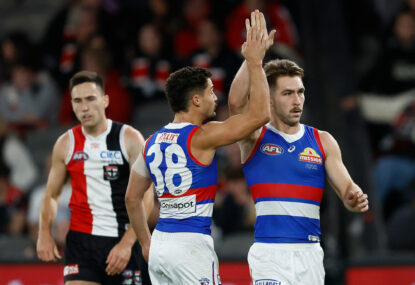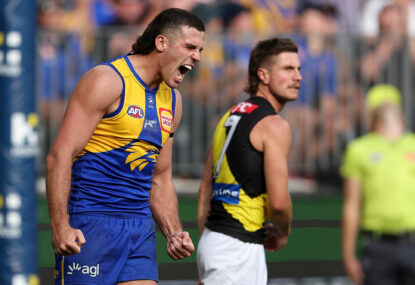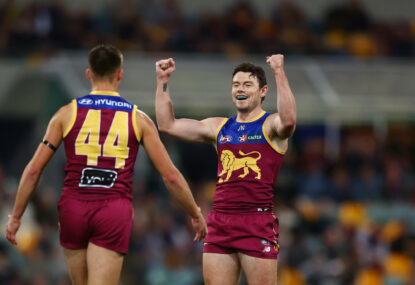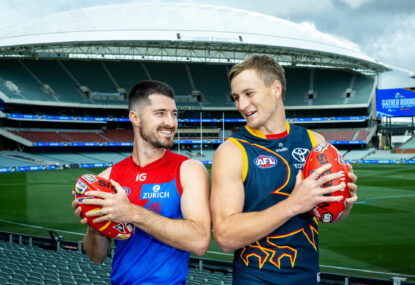Last week, news emerged that long-time St Kilda recruiting manager Tony ‘Trout’ Elshaug had decided to step down as a response to the team’s dismal season.
It’s fair enough the club has decided personnel changes are necessary, and that they want to be seen to be doing something to rectify the on-field situation.
However, Elshaug’s resignation suggests the club believes its issues lie solely in the drafting and recruiting of players, which fails to acknowledge the need for a thorough, wide-ranging review.
Elshaug’s departure seems even more strange when we judge his recruiting performance based on the metrics that the club itself outlined in their strategic blueprint at the end of 2013.
The club aimed to use recruiting to be a premiership contender by 2020. This involved securing as many top-20 draft selections as possible, then aggressively pursuing free agency from 2016 onwards.
At the micro level, some specific positional areas of weakness were identified – such as a dearth of key defenders and the need for more outside speed – to be addressed through recruiting.
Looking back now at 2013 to the end of 2017, Elshaug and his team more than achieved the first part of that goal.
The club undertook some aggressive trading to secure high draft picks, including the Ben McEvoy to Hawthorn in 2013 that netted picks 18, 19, and Shane Savage, as well as sending ruckman Rhys Stanley to Geelong in exchange for pick 21.

AAP Image/Tony McDonough
Trades such as these allowed the Saints to acquire eight picks inside the top 22 in the five-year period, selecting midfielders Luke Dunstan, Blake Acres, Jack Billings, and Daniel McKenzie; forwards Paddy McCartin, Hugh Goddard, Jade Gresham, and Hunter Clark; and running defender Nick Coffield.
The club also managed to address list deficiencies through trading, acquiring ruckman Billy Longer, forwards Tim Membrey and Josh Bruce, midfielders Koby Stevens, Nathan Freeman and Jack Steele, and defenders Jake Carlisle and Logan Austin.
The top 20 players the club acquired were considered talents in their draft years, and so, taken together, should have created a nucleus to develop over the coming years.
Pundits have questioned the decision to take Paddy McCartin over Christian Petracca in 2014, given the current career progress of both, but the reality is that most clubs were divided on which player they would have taken had they had the number one choice. You can’t fault Elshaug and his team for choosing McCartin – the club desperately needed a key forward, and in McCartin they saw someone they could build the forward-line around for many years to come.
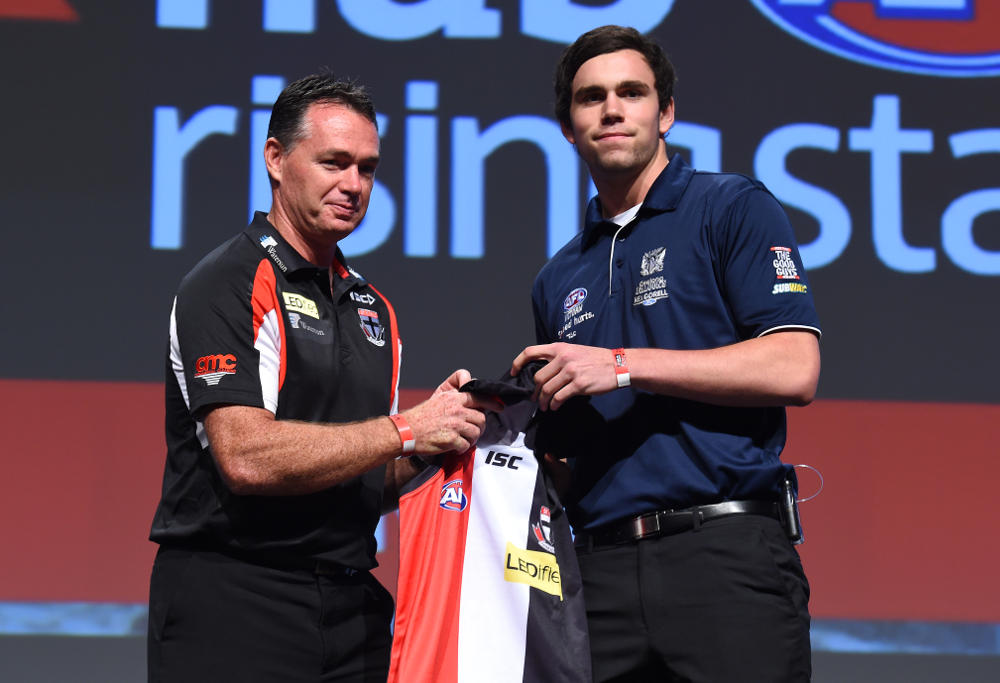
AAP Image/Dave Hunt
Where the strategy fell down was in the aim of attracting big-name free agents, with the club managing to lure only Nathan Brown since 2016.
However, this wasn’t through lack of trying – the Saints unsuccessfully made pitches to Greater Western Sydney midfielder Josh Kelly and several other midfielders. This isn’t the fault of the recruiting team – it’s become a trend that free agents usually only move to clubs that are in finals contention.
It’s true also that St Kilda haven’t had many successes with rookies or players taken later in the draft – only Mav Weller, Jack Sinclair, and Jack Lonie have become AFL regulars in recent years. However, defenders Brandon White and Bailey Rice, along with forward Josh Battle and midfielder Ed Phillips, all taken in the last two years at pick 39 or later, look capable.
So, given Elshaug and his team have achieved the club’s recruiting plan, some of the responsibility for the club’s current fortunes should rest with the player development staff.
Of the aforementioned players, I’d argue that only Acres, Sinclair, White and Rice have improved (it’s still too early to tell with those recruited from 2016 onwards, but Battle, Phillips, and Rowan Marshall, in particular, have shown good signs).
The caveat here is that McCartin, Goddard, McKenzie, White, and Long have all been plagued by severe or multiple injury issues over the past few seasons that have hampered their development. Still, when they have played, they haven’t yet shown the promise hoped for when recruiting them.
Why has this development been such an issue? A few things come to mind.
First is conservative team selection. St Kilda have a tendency to choose experienced but limited players over younger, talented players – case in point is the continual selection of Savage, Weller, Sam Gilbert – as well as selecting underperforming players – Lonie has been a case in point here, at various times.
Last weekend, against Gold Coast, David Armitage and Weller were brought back at the expense of Coffield, to add more experience for what loomed as a winnable game.
Yes, Coffield is a first-year player and needs to be managed, but at the moment he can’t get any consistency, seemingly playing one good game, being dropped for a week or two, then being selected again. Phillips, White, Rice, Battle, Clark, and Marshall have all also been victims of this.
Players are also being played out of position – the biggest one here is Jack Billings, who has consistently been used as a high half-forward, where he struggles to find the ball, instead of as a midfielder, where he plays his best football.
After a lean patch, he was dropped two weeks ago, and went back and amassed 53 disposals in the VFL. Of course he did. Because the problem hasn’t been with Billings and his ability, it’s been the fact that his role hasn’t allowed him to play to his strengths.

Photo by Michael Willson/AFL Media/Getty Images
Another factor is that, with the retirements of champion Leigh Montagna and Nick Riewoldt at the end of last season, the club lacks leaders. Outside of captain Jarryn Geary, Dylan Roberton, Jimmy Webster, Jack Steven, Seb Ross, and Armitage, leaders are short on the ground for this young side.
Finally, there’s coaching.
The players are down on confidence, as evidenced by their abysmal goal kicking, despite all the training they’ve done in this area (Ben Dixon was hired as a specialist goal-kicking coach at the end of last year) – which likely comes down to the way the players are being coached and the type of gameplan being employed.
The team seem confused as to what they’re meant to do, and how to go about executing it. There’s no cohesion in their play, and no confidence to back themselves.
You can argue whether the players recruited can develop into stars, but the club overrated its list when it created the strategy blueprint. It has also either not tailored the gameplan to the players recruited, or not recruited players who can play in a specific style.
The plan to bolster the areas of concern was a good one, as there were numerous holes that needed filling, but this seems to have come at the expense of a cohesive recruiting strategy, designed to achieve a common purpose.
Take the Hawthorn and Geelong juggernauts, teams characterised by specific game styles, who recruited players capable of playing that way. With the Saints, on the other hand, it feels like a scatter-gun approach.
[latest_videos_strip category=”afl” name=”AFL”]
This has also been the issue with the club’s attempts to lure free agents. It seems that the club is interested in throwing money at anyone willing to come, regardless of how that player balances the list.
Take Adelaide’s Rory Sloane – clearly a fine player, who would undoubtedly improve the quality of the Saints’ list, but is he what they need? I’d argue not, given inside midfielders is one area in which the club has a surfeit of players.
Acquiring a big-name free agent just because you can speaks volumes of a club’s panic about the lack of star quality on the list, and a desire to score some marketing and promotion points.
So, where to from here? For the rest of the season, I’d like to see the Saints play a young team that gives players the best chance of developing continuity and building a rapport with each other, particularly the back six.
This means that players like White, Rice, Phillips, Coffield, Clark, Austin, Battle, and Long should, barring injuries, play the majority of games together. Yes, it will be a young team, but with the club’s season already all but over, they should develop younger players.
At the end of the season, the club should bring in players through the trade period who would add a touch of class, whether in the midfield or forward line. However, this should not be done willy-nilly, or just for the sake of doing so. Any recruitment should be done with a clear view of the list strategy and gameplan.
Off-field, the club should follow the lead of Collingwood and Richmond, and conduct a wholesale, thorough review of player development, goal-kicking, and personnel. This is the only way to truly acknowledge – and resolve – the issues that have led to the current on-field position, and would show members and supporters that improvement is being taken seriously.
Bandaid moves, like moving Tony Elshaug on, will continue to consign St Kilda to irrelevancy in the AFL world.





























































































